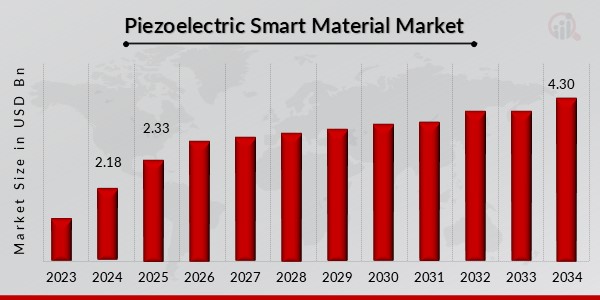The global piezoelectric smart material market is experiencing significant growth, driven by an escalating demand for advanced sensors, actuators, and energy-harvesting solutions across a multitude of industries. These remarkable materials, capable of converting mechanical stress into electrical energy and vice versa, are at the forefront of innovation, enabling smarter, more efficient, and more responsive technologies. From revolutionizing aerospace and defense to enhancing healthcare and consumer electronics, piezoelectric smart materials are carving out a substantial and ever-expanding niche in the global economy.
Market Size and Growth Trajectory:
the Piezoelectric Smart Material Market Size was estimated at 2.18 (USD Billion) in 2024. The Piezoelectric Smart Material Market Industry is expected to grow from 2.33 (USD Billion) in 2025 to 4.30 (USD Billion) by 2034. The Piezoelectric Smart Material Market CAGR (growth rate) is expected to be around 7.01% during the forecast period (2025 – 2034).
Key Drivers Propelling Market Expansion:
Several critical factors are fueling the rapid expansion of the piezoelectric smart material market:
- Growing Demand for Advanced Sensors and Actuators: The core strength of piezoelectric materials lies in their ability to act as highly sensitive sensors and precise actuators. Industries like automotive, aerospace, industrial automation, and consumer electronics are increasingly integrating piezoelectric components for applications requiring rapid response times, high sensitivity, and energy efficiency. This includes everything from pressure sensors in automotive safety systems to precise motion control in robotics and touch-sensitive interfaces in consumer devices.
- Expansion in Aerospace and Defense: The military and aerospace sectors are significant drivers of demand for piezoelectric smart materials. These materials are crucial for structural health monitoring, vibration control, and sophisticated actuator systems in aircraft and satellites. They help address challenges such as engine vibrations, cabin noise reduction, ice accumulation on wings, and turbulence-induced flow separation, ensuring enhanced performance, safety, and reliability in demanding environments.
- Increasing Utilization in Healthcare Technologies: The healthcare sector is witnessing a surge in the adoption of piezoelectric materials for a wide range of applications. This includes high-quality ultrasound imaging, miniature wearable biosensors for continuous health monitoring, and smart prosthetics that offer improved functionality and patient comfort.
- Rise of IoT and Smart Systems: The proliferation of the Internet of Things (IoT) and the growing trend towards automation are creating a significant demand for piezoelectric materials. Their ability to convert ambient vibrations into usable electrical energy makes them ideal for self-powered devices and wireless sensors, crucial components for building intelligent, interconnected systems.
- Focus on Energy Efficiency and Harvesting: With a global emphasis on sustainable energy solutions, piezoelectric materials are gaining traction in energy harvesting applications. They can capture kinetic energy from motion or vibrations and convert it into electrical energy, providing power for low-power electronic devices, remote sensors, and wearable technology, thereby reducing reliance on traditional batteries.
- Advancements in Fabrication Technologies: Innovations in manufacturing processes, including additive manufacturing (3D printing), are making it possible to produce high-performance piezoelectric materials more efficiently and at lower costs. This enables the creation of custom-designed materials and devices with tailored properties, further expanding their application potential.
Diverse Applications Across Industries:
The versatility of piezoelectric smart materials translates into a broad spectrum of applications:
- Automotive: Piezoelectric sensors are used in airbag systems for impact detection, engine knock sensors, and tire pressure monitoring systems. Piezoelectric actuators contribute to fuel efficiency and emission control.
- Aerospace & Defense: Structural health monitoring, active vibration damping, smart skins, and precision control surfaces in aircraft and satellites.
- Consumer Electronics: Touchscreens, inkjet printers, micro-speakers, haptic feedback devices, and energy harvesting in wearables.
- Healthcare: Ultrasound transducers for imaging and diagnostics, wearable biosensors, smart drug delivery systems, and surgical tools.
- Industrial & Manufacturing: Non-destructive testing, precision motion control systems, robotics, and industrial automation for material handling and sorting.
- Energy Harvesting: Powering wireless sensors, IoT devices, and low-power electronics by converting ambient vibrations into electrical energy.
- Marine: Sonar systems, hydrophones, and underwater submersible equipment.
Market Segmentation:
The piezoelectric smart material market can be segmented by material type (ceramics, polymers, composites, single crystals), application (sensors, actuators, energy harvesting, medical devices, others), and end-use industry (aerospace, automotive, consumer electronics, healthcare, industrial, etc.). Ceramics, particularly Lead Zirconate Titanate (PZT), currently dominate the market due to their superior piezoelectric properties. However, there is growing interest in polymer-based and lead-free piezoelectric materials due to their flexibility, lightweight nature, and environmental considerations.



